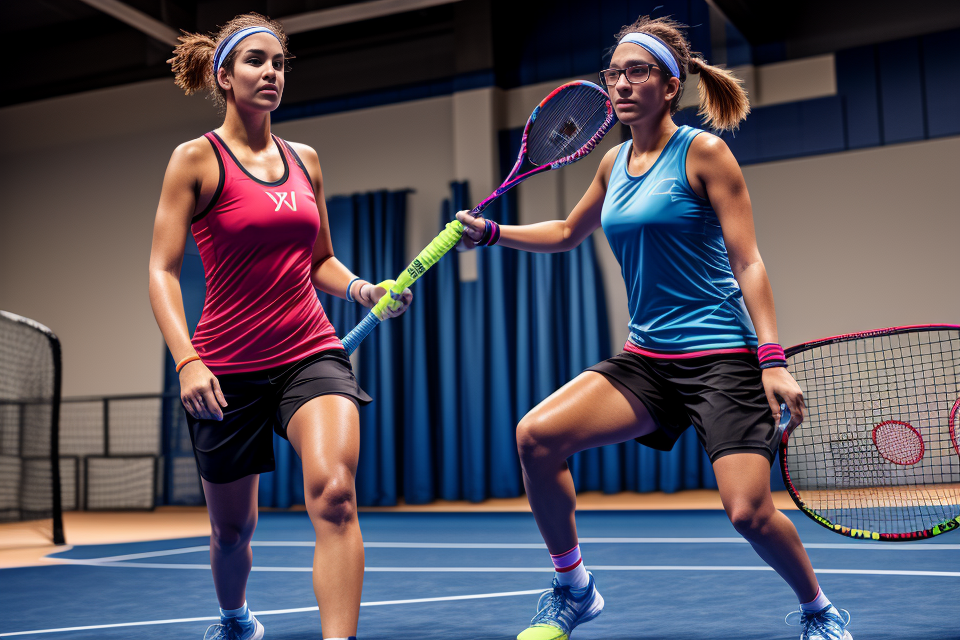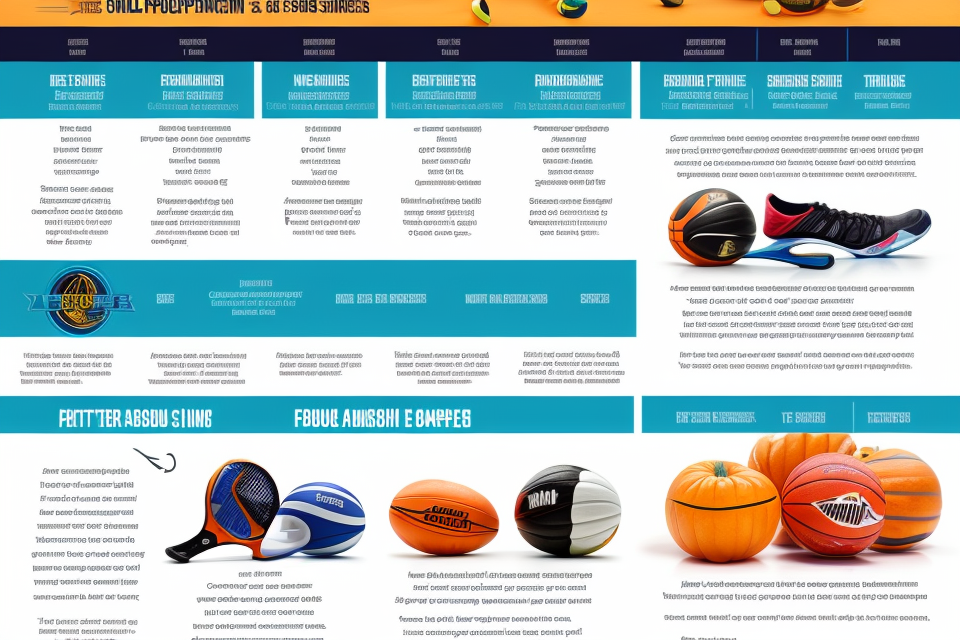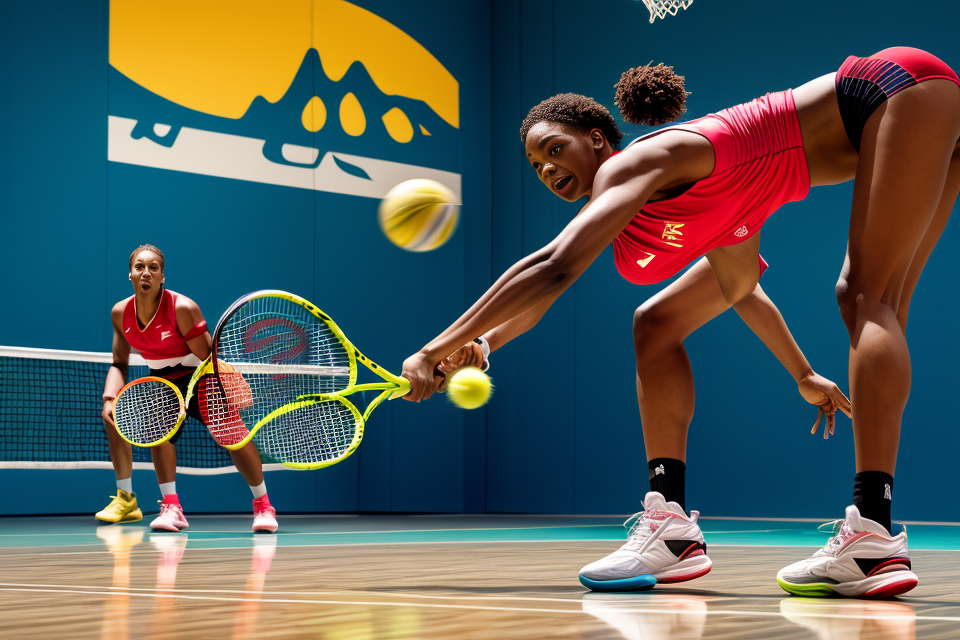Are you ready to take your squash game to the next level? Whether you’re a beginner or an experienced player, training is essential to improve your skills and achieve your goals. In this article, we’ll explore the best tips and drills for how to train effectively for squash. From cardio exercises to technical drills, we’ll cover everything you need to know to elevate your game. So lace up your shoes, grab your racquet, and let’s get started!
Warm-Up and Cardio Exercises
Importance of Warm-Up and Cardio Exercises
- Warm-up exercises are crucial to prevent injuries by increasing blood flow to the muscles and preparing them for physical activity.
- Cardio exercises such as running, cycling, or swimming are essential for improving cardiovascular endurance, which is critical for squash players as the sport requires short bursts of intense activity followed by periods of recovery.
- Warm-up and cardio exercises also help in enhancing performance by increasing oxygen and nutrient delivery to the muscles, which can improve reaction time, speed, and agility on the squash court.
- A proper warm-up routine should include dynamic stretching exercises that focus on the major muscle groups used in squash, such as the legs, core, and upper body.
- A gradual progression of intensity and duration of cardio exercises should be implemented to avoid overexertion and allow the body to adapt to the training.
Examples of Warm-Up and Cardio Exercises
Before diving into any intense physical activity, it is essential to warm up your body to prevent injury and improve performance. Cardio exercises are also important to improve your endurance and stamina on the squash court. Here are some examples of warm-up and cardio exercises that you can incorporate into your training routine:
Light Jogging
Light jogging is a great way to get your heart rate up and loosen up your muscles before a workout. It is important to start slowly and gradually increase your pace and distance as you become more comfortable.
Jumping Jacks
Jumping jacks are a classic warm-up exercise that engages your entire body. They are a great way to get your heart rate up and increase your overall energy levels. Start with 10-15 repetitions and gradually increase the number as you become more comfortable.
High Knees
High knees are a drill that focuses on your legs and core. To perform high knees, stand with your feet shoulder-width apart and run in place while bringing your knees up towards your chest. This exercise is great for improving your leg strength and endurance.
Butt Kicks
Butt kicks are a variation of high knees that target your glutes and hamstrings. To perform butt kicks, stand with your feet shoulder-width apart and run in place while kicking your heels towards your buttocks. This exercise is great for improving your lower body strength and flexibility.
Dynamic Stretching
Dynamic stretching involves active movements that increase your range of motion and flexibility. Examples of dynamic stretches include leg swings, arm circles, and hip openers. These exercises are great for improving your mobility and reducing the risk of injury.
By incorporating these warm-up and cardio exercises into your training routine, you can improve your overall fitness and performance on the squash court. Remember to start slowly and gradually increase the intensity and duration of your workouts over time.
Squash-Specific Drills
Improving Footwork and Movement
Proper footwork and movement are crucial in squash, as it requires quick changes of direction and the ability to move efficiently around the court. The following drills can help improve footwork and movement in squash:
Lunges
Lunges are a great exercise to improve footwork and leg strength. To perform a lunge, start with your feet shoulder-width apart and take a large step forward with one foot. Bend both knees to lower your body, keeping your weight on the balls of your feet. Push off the back foot to return to the starting position. Repeat with the other leg.
Shuffling drills
Shuffling is a fundamental movement in squash and can be practiced with shuffling drills. To perform a shuffle, take a small step to the right or left with the foot closest to the wall, then take a small step with the other foot. Repeat the process, moving your feet quickly and keeping your weight on the balls of your feet.
Multidirectional movements
To improve footwork and movement in all directions, multidirectional movements can be practiced. For example, start in the center of the court and move to the front right corner by taking a step to the right and then a step forward. Then, move to the back right corner by taking a step to the right and then a step backward. Repeat for the other three corners.
By incorporating these drills into your training routine, you can improve your footwork and movement on the squash court, which will help you perform better in matches.
Enhancing Strength and Power
Strength Training Exercises for Squash-Specific Muscles
Strength training is an essential component of any athletic training program, including squash. Squash-specific muscles that require strength training include the legs, core, and upper body. The following exercises can be included in a strength training program for squash players:
- Squats: This exercise targets the legs, specifically the quadriceps, hamstrings, and glutes. It is an excellent exercise for improving lower body strength and power.
- Deadlifts: This exercise targets the hamstrings, glutes, and lower back muscles. It is an excellent exercise for improving overall lower body strength.
- Lunges: This exercise targets the legs, specifically the quadriceps, hamstrings, and glutes. It is an excellent exercise for improving lower body strength and power.
- Bench press: This exercise targets the chest, shoulders, and triceps. It is an excellent exercise for improving upper body strength.
- Pull-ups: This exercise targets the back muscles, specifically the latissimus dorsi. It is an excellent exercise for improving upper body strength.
Plyometric Exercises
Plyometric exercises are designed to improve power and explosiveness. They involve quick, explosive movements that help to develop the ability to jump higher, move faster, and change direction quickly. The following plyometric exercises can be included in a training program for squash players:
- Box jumps: This exercise involves jumping up onto a box from a standing position. It is an excellent exercise for improving power and explosiveness in the legs.
- Depth jumps: This exercise involves jumping from a squat position into a pit or a pool. It is an excellent exercise for improving power and explosiveness in the legs.
- Bounding: This exercise involves bounding or hopping along a straight line or around cones. It is an excellent exercise for improving power and explosiveness in the legs.
Medicine Ball Exercises
Medicine ball exercises are designed to improve core stability and power. They involve using a medicine ball to perform various exercises that target the abdominal and back muscles. The following medicine ball exercises can be included in a training program for squash players:
- Medicine ball slams: This exercise involves holding a medicine ball with both hands and slamming it onto the ground as hard as possible. It is an excellent exercise for improving power in the core muscles.
- Medicine ball sit-ups: This exercise involves lying on the ground with a medicine ball behind the head and sitting up as quickly as possible. It is an excellent exercise for improving core stability and power.
- Medicine ball Russian twists: This exercise involves sitting on the ground with a medicine ball in both hands and twisting the torso from side to side. It is an excellent exercise for improving power in the oblique muscles.
Overall, incorporating these strength and power exercises into a training program can help squash players improve their performance on the court. It is important to consult with a fitness professional or a sports coach to develop a comprehensive training program that is tailored to individual needs and goals.
Developing Accuracy and Precision
To develop accuracy and precision in squash, it is important to practice specific drills that target these skills. Here are some drills that can help:
- Target practice with ball: This drill involves standing in one spot and hitting the ball towards a specific target on the wall. The target can be a specific point on the wall or a specific area of the court. The aim is to hit the ball accurately and consistently towards the target. This drill can help improve accuracy and precision in squash.
- Volley and drop shots drills: Volley and drop shots are important shots in squash that require precision and accuracy. To practice these shots, set up a drill where a partner feeds the ball to you and you have to hit a volley or drop shot to a specific target on the court. This drill can help improve your ability to hit precise shots in squash.
- Angle and court positioning drills: In squash, it is important to be in the right position on the court to hit accurate and precise shots. To practice angle and court positioning, set up a drill where a partner feeds the ball to you and you have to hit the ball to a specific target on the court while moving to the correct position on the court. This drill can help improve your ability to hit accurate and precise shots while in the right position on the court.
Match Simulation and Drills
Drills to Improve Match Play
Drills to Improve Match Play are an essential part of any squash training program. These drills are designed to simulate match conditions and help players develop the skills and strategies needed to perform well in real matches.
Point play drills
Point play drills are designed to simulate the pressure and intensity of a real match. These drills can be used to improve shot selection, movement, and decision-making under pressure. Examples of point play drills include:
- Warm-up drills: These drills are used to get the player warmed up and ready for the session. They may include simple exercises such as hitting against the wall or light jogging.
- Serve and return drills: These drills focus on the serve and return of serve. Players can practice different types of serves, such as the drive serve or the drop serve, and work on returning their opponent’s serve.
- Rally drills: These drills involve hitting the ball back and forth with a partner. They can be used to improve shot selection, movement, and court positioning.
Small-sided games
Small-sided games are a great way to simulate match conditions and improve teamwork and communication skills. Examples of small-sided games include:
- One vs. one: This game involves two players playing against each other. It can be used to improve shot selection, movement, and decision-making under pressure.
- Two vs. two: This game involves four players playing on the same team. It can be used to improve teamwork, communication, and strategy.
- Three vs. three: This game involves six players playing on two teams. It can be used to improve court coverage, positioning, and tactics.
Match simulation drills
Match simulation drills are designed to simulate the physical and mental demands of a real match. These drills can be used to improve fitness, endurance, and mental toughness. Examples of match simulation drills include:
- Interval training: This involves alternating periods of high-intensity exercise with periods of rest. It can be used to improve fitness and endurance.
- Mental toughness drills: These drills focus on improving mental toughness and resilience. Examples include visualization exercises, positive self-talk, and stress management techniques.
- Match-like scenarios: These drills simulate match conditions by replicating the score, time pressure, and tactics used in real matches. They can be used to improve decision-making, concentration, and composure under pressure.
Tips for Match Preparation
- Analyzing opponent’s game
Before a match, it is crucial to analyze your opponent’s game style, strengths, and weaknesses. This analysis will help you develop a strategy to counter their playing style and exploit their weaknesses. To do this, you can watch their previous matches, study their playing style, and talk to other players who have played against them. - Visualizing match scenarios
Visualization is a powerful tool that can help you prepare mentally for a match. By visualizing yourself playing in different match scenarios, you can build confidence, reduce anxiety, and improve your focus. You can visualize yourself winning important points, making crucial shots, and dealing with difficult situations. This will help you to perform at your best when it matters most. - Mental preparation and visualization techniques
Mental preparation is just as important as physical preparation in squash. To mentally prepare for a match, you can use visualization techniques, such as guided imagery and mental rehearsal. These techniques involve visualizing yourself performing well in different match scenarios, which can help you build confidence, reduce anxiety, and improve your focus. Additionally, you can use positive self-talk, relaxation techniques, and mindfulness practices to help you stay calm and focused during a match.
Nutrition and Recovery
Importance of Proper Nutrition
Proper nutrition is essential for athletes to fuel their bodies and optimize their performance on the squash court. It plays a crucial role in energy production, muscle recovery and growth, and immune system support.
- Energy Production: Carbohydrates are the primary source of energy for the body, particularly during high-intensity activities such as squash. Consuming adequate amounts of carbohydrates can help sustain energy levels during training and matches.
- Muscle Recovery and Growth: Protein is necessary for building and repairing muscles. Athletes should aim to consume sufficient amounts of protein after training sessions to support muscle recovery and growth.
- Immune System Support: A healthy immune system is vital for preventing illnesses that can affect training and performance. Vitamins and minerals, such as vitamin C and iron, can help support the immune system.
Overall, proper nutrition is a crucial aspect of training effectively for squash. Athletes should aim to consume a balanced diet that includes a variety of nutrient-dense foods to fuel their bodies and optimize their performance on the court.
Tips for Optimal Nutrition
Balanced Diet
A balanced diet is crucial for optimal nutrition and overall health. It should consist of a variety of nutrient-dense foods from different food groups, including:
- Fruits and vegetables: These provide essential vitamins, minerals, and fiber.
- Whole grains: They offer carbohydrates, fiber, and essential nutrients.
- Lean protein sources: These include poultry, fish, beans, and legumes, which help build and repair muscles.
- Healthy fats: Nuts, seeds, avocados, and olive oil are good sources of healthy fats that support energy levels and overall health.
Hydration
Staying adequately hydrated is vital for optimal performance during squash training and matches. Drink plenty of water throughout the day, and consider adding electrolyte-rich beverages, such as coconut water or sports drinks, to support hydration and maintain electrolyte balance.
Timing of Meals and Snacks
The timing of meals and snacks can have a significant impact on your energy levels and performance during squash training. Here are some tips for optimal nutrition:
- Consume a balanced meal 2-3 hours before training, focusing on complex carbohydrates and lean protein sources.
- Have a light snack, such as fruit or a protein bar, about an hour before training to provide a quick energy boost.
- Refuel with a post-workout snack, including carbohydrates and protein, within 30 minutes of finishing training to replenish energy stores and support muscle recovery.
- Keep healthy snacks, such as nuts, fruit, or protein bars, readily available for energy-boosting between meals.
Importance of Recovery
- Reduces muscle soreness and injury risk: Proper recovery plays a crucial role in minimizing muscle soreness and injury risk. Engaging in adequate recovery techniques enables the muscles to repair and rebuild, thus reducing the likelihood of injury during intense squash training sessions.
- Enhances muscle repair and growth: Recovery is vital for optimizing muscle repair and growth. A well-designed recovery program, including proper nutrition and rest, supports the process of muscle protein synthesis, which is essential for muscle development and overall performance enhancement.
- Improves mental and physical performance: Effective recovery has a positive impact on both mental and physical performance. It helps reduce fatigue, improves focus and concentration, and enables athletes to maintain high levels of intensity during training and competition. Proper recovery strategies also contribute to better sleep quality, which is essential for overall well-being and performance optimization.
Recovery Techniques
Recovery techniques are crucial for optimizing your physical and mental performance on the squash court. Proper recovery enables your body to repair and rebuild muscle tissue, reduce soreness, and improve overall fitness. Here are some effective recovery techniques for squash players:
- Rest and Sleep: Adequate rest and sleep are essential for optimal recovery. Aim for at least 7-9 hours of sleep per night and take regular breaks between training sessions to allow your body to recover.
- Active Recovery Exercises: Active recovery exercises, such as light jogging, cycling, or swimming, can help improve blood flow and reduce muscle soreness. These exercises should be low-intensity and non-impact to avoid further injury.
- Massage and Foam Rolling: Massage and foam rolling are effective techniques for releasing muscle tension and improving circulation. Regular massage can help to loosen tight muscles, while foam rolling can be used to target specific areas of the body, such as the IT band or quadriceps.
- Nutrition for Recovery: Proper nutrition is vital for supporting recovery and maintaining energy levels. Consume a balanced diet that includes a variety of fruits, vegetables, whole grains, lean proteins, and healthy fats. Post-workout, aim to consume a combination of carbohydrates and protein to replenish energy stores and support muscle repair. Hydration is also essential, so make sure to drink plenty of water throughout the day.
By incorporating these recovery techniques into your training routine, you can improve your overall performance on the squash court and reduce the risk of injury. Remember, recovery is just as important as training, so make sure to prioritize it in your regimen.
FAQs
1. What are the key elements of an effective squash training program?
An effective squash training program should include a combination of physical conditioning, technical skill development, and match-specific tactics. This can include a mix of cardiovascular exercise, strength training, agility drills, and match simulation drills.
2. How often should I train for squash?
The frequency of training will depend on your individual goals and fitness level. However, as a general guideline, it is recommended to train at least 3-4 times per week, with at least one of those sessions being a match simulation drill.
3. What are some effective drills for improving my squash skills?
There are many different drills that can help improve your squash skills, depending on your specific areas of focus. Some effective drills include hitting against a wall or machine to improve your accuracy and power, practicing your footwork and agility with ladder drills, and working on your volleys and drop shots with partner drills.
4. How can I improve my cardiovascular fitness for squash?
Cardiovascular fitness is important for squash because it helps you maintain a high level of activity throughout the match. To improve your cardiovascular fitness, you can incorporate activities such as running, cycling, or swimming into your training routine. It is also important to include interval training, which involves periods of high-intensity exercise followed by periods of rest, to simulate the demands of a squash match.
5. What are some tips for preventing injury while training for squash?
To prevent injury while training for squash, it is important to warm up properly before each session and cool down afterwards. You should also make sure to stretch regularly to improve flexibility and reduce the risk of muscle strain. Additionally, it is important to listen to your body and not push yourself too hard, as this can lead to injury. If you experience any pain or discomfort, it is best to rest and seek medical advice if necessary.










